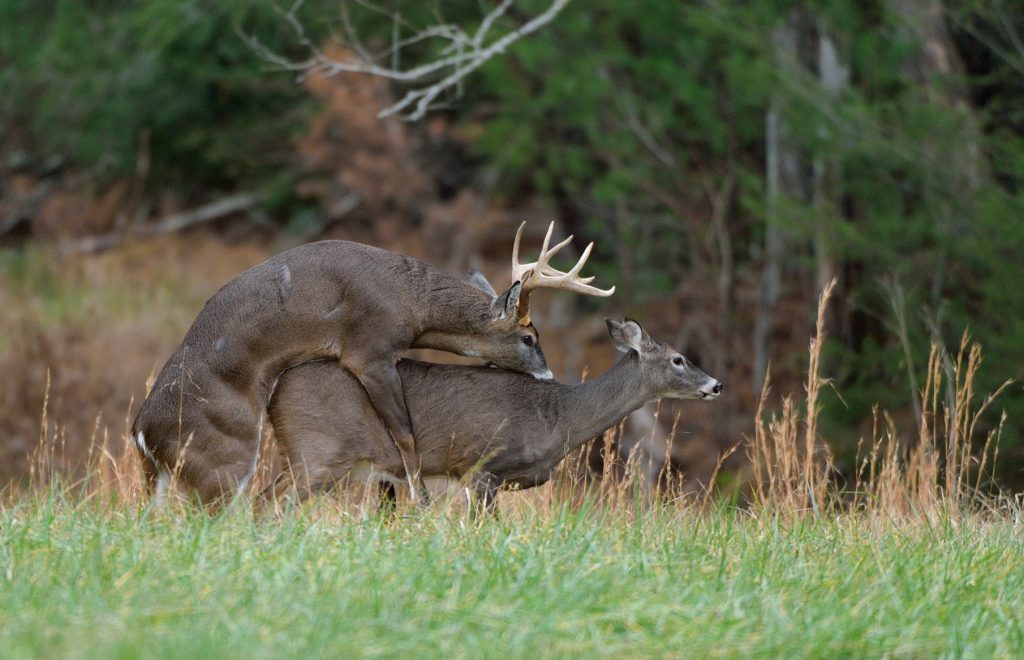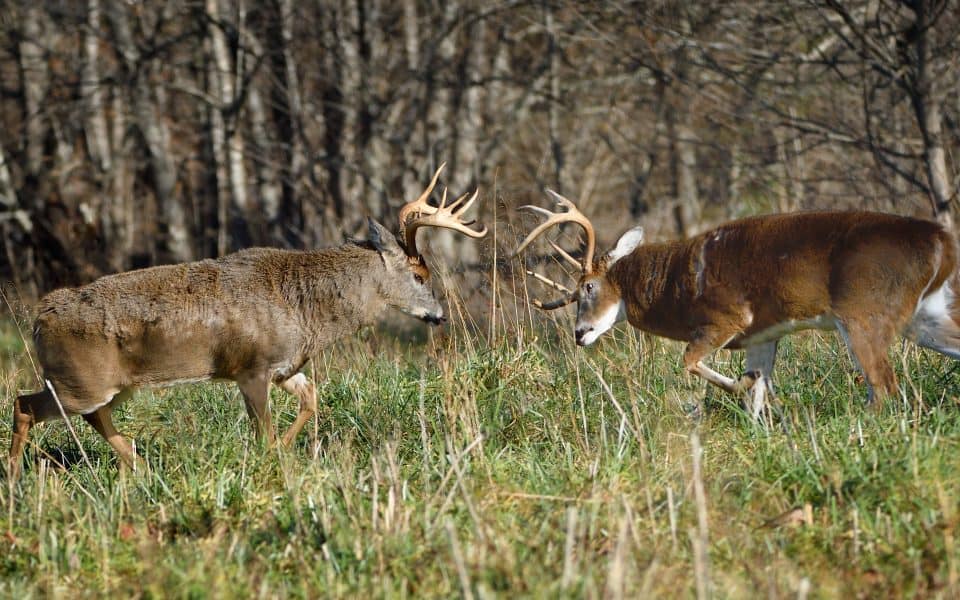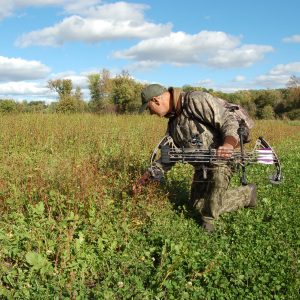Perched in a ladder-stand on a frosty morning, overlooking an expanse of swale grass and dense shrub thickets I felt my phone vibrate in my pocket. It was a friend and hunting companion whom was several hours north and wondering how things were progressing back home. “It’s been very slow…” I began typing, intending to go on about how I had only seen a few does and the bucks weren’t moving at all yet. My efforts were interrupted by a sound that could easily have been mistaken for a creaky tree protesting against the wind, were it not a dead calm day.
The next grunt was unmistakable, and reinforced by the staccato steps of hooves on frozen leaves. A doe burst from cover and paused momentarily in an opening directly in front of me before glancing down her back trail then running off. My rifle was up and ready when the next deer entered the opening and made a fatal pause, sunlight glinting off his antlers. My next text was one word: “Done!” The whitetail rut had arrived, and brought with it early success.
In the interest of full disclosure, I’d been expecting it, any day. This particular spot had a recent history of producing, and according to the calendar, the timing was right. There are never any guarantees in deer hunting, but the odds seemed ever so slightly slanted in my favor.

Linda Arndt
When Will the Whitetail Rut Begin?
It’s one of the most common questions and often debated topics among deer hunters. Hunting lore and old-timer’s tales are rife with predictors for when the whitetail rut will arrive. Some say it’s related to moon phase, others claim it comes with the first hard frost. Some predict it will be early this year based on some prognostication of a hard winter or a bumper mast crop and others claim, “It’s late this year because it’s been so warm.”
Everyone wants to know when the rut will be. It’s prime time, when the action is hottest and a big buck could show up almost anywhere, at any time. People plan days off and weeklong vacations around it, hoping they’ll hit the right dates. In turn, they’re overwhelmed with all sorts of information and misinformation. The truth is, predicting peek rut is not nearly as difficult as some think and others are willing to admit. Even better, it’s really quite consistent.
The key variable is where you live, or hunt. Whitetails are rutting somewhere within their range from August all the way through February – in some cases even outside that window. However, peek rut is much more precise and consistent within a specific geographic area. Allow me to explain.

J Edwards
Before we reveal the big secret to prediction though, we need some clarification on terminology. The term “rut” encompasses all behavior associated with breeding. This includes the build-up period of bucks sparring and sorting out dominance, opening and tending scrapes and searching for the first hot does – what many hunters refer to as pre-rut. Peek rut is then when activity and movement are greatest, when the most deer are on their feet and moving. Post rut is a wind-down period, but there will be a slightly less dramatic second act.
Rather than “peek rut,” biologists are more concerned with “peak breeding” – when the majority of adult does are in estrus and ready, willing and able to breed. Depending on population dynamics, it can be protracted or compacted. Either way, it occurs over a certain span of time. If you were to graph the number of does that are in estrus on each day for a specific area it would appear as a bell curve, building slowly from lower numbers early on, up to the peak and then down again.
Peek rutting activity may or may not coincide. Often there is more activity before peek breeding as bucks are seeking and chasing does that may not be quite ready, but love is in the air. Daytime rutting activity may actually taper off during peak breeding as more bucks and does are paired up and have slipped off to some secluded place until the doe is ready to stand for the buck.
Knowing the Peak Rut Time
Rather than saving the best for last, we’ll jump right into it now. Biologists don’t exactly predict when the rut will occur, but they can tell you when peak breeding did occur. They do this primarily by measuring fetal samples, from hunter-killed deer, road kills and scientifically collected specimens (see sidebar: Fetal Aging). They’ve been doing this for years, decades, so they have a pretty solid foundation upon which to base their analysis. What they have determined is… drum roll, please… for any given area, peak breeding occurs at roughly the same time every year. Restated: It doesn’t change, regardless of moon phase, weather, temperature, solunar tables or the Old Farmer’s Almanac.

Bob Humphrey
I did a little research on their research. In 2011, I contacted deer biologists from every state and several provinces in the whitetail’s range and asked when their peak rut occurs. Many gave different dates but all concurred that those dates did not change year to year. Last year I checked back again and results were the same. Peak breeding dates had not changed for any state or specific region within that state or province.
Despite the science, skepticism remains and hunters ask, “Why hasn’t the rut kicked in yet?” It likely has; you’re just not seeing it. This might be where that old misconception about a good cold snap originated, and why a cold frosty morning just might be the best time to be in the woods. By the time rut rolls around, deer are wearing their winter coats. You can take yours off but they can’t so when it gets too warm, they simply move less during the day. This is something of a generality, and I’ve observed many a randy buck chasing does on a hot, sunny afternoon. However, there is some research demonstrating that daytime movement, at least in northern deer, drops off as temperatures rise above the high 40s. That’s less the case for southern deer and deep cold might even suppress activity there for a short period. However, when the time is right, the rut goes on, it just might happen more under cover of darkness.
Hunting pressure is another variable that can suppress observable rutting behavior. There’s plenty of research showing that deer learn very quickly how to avoid humans. They simply move less during daylight and more in thick cover. The scent of a hot doe can make even the wariest buck drop his guard occasionally, but the odds go down as human presence increases.
The Peak Rut Varies by Area
While peak breeding is consistent for any given area, it can and does vary from one area to another, sometimes by quite a bit. Somewhere in Texas, the rut is peaking any time from late September to late December. Gulf Coast states have highly variable regional differences and in Florida, deer might be rutting anytime from late July to mid-February. In northern latitudes, it’s much more consistent, for a couple reasons.
The primary trigger for when does enter estrus is photoperiod – the interval in a 24-hour period during which a plant or animal is exposed to light. This influences hormonal production. Because of the sun’s angle and the wider range of daylight lengths from summer into winter, peek breeding tends to be more synchronous and occur over a shorter span in northern latitudes.

Tes Jolly
There are also selective pressures at work. Eons have honed the whitetail’s breeding cycle so that fawns are born when they have a greater chance of survival. If they’re born too early, it may be too cold, or there may not be enough food available. Too late and they won’t have sufficient time to grow big enough to survive winter. Because day length differences are less extreme and winters less severe, southern ruts tend to be more protracted and varied. There’s also some speculation that translocation of northern deer could contribute to greater variability.
Can You Determine the Peak Rut In Your Area?
How can you determine when peak breeding, or peak rut will occur in your area? The easiest way is to consult your local state biologist. Many states even have data available on their websites. Keeping a journal can also be very helpful. In fact, that’s what led to my being in that ladder stand described in the opening passage. It took several seasons, but my son and I eventually fine-tuned the optimum dates to hunt that particular stand based on experience and overall activity at other locations. It produced during the same week in four consecutive years, until the neighbor unwittingly set up a stand in the bedding area and spoiled the area for all.
The Second Rut
If you miss peak rut because you couldn’t get out in the field when it occurred, a warm front subdued daytime activity, or the deer where you hunt just weren’t cooperating there’s still hope. Often a few does aren’t bred during the first rut. They’ll cycle again roughly 28 days later. Rutting activity will be less intense and synchronous because there are fewer of them, and they may not be as closely aligned to the previous peak, but they might just draw a buck out of hiding when the sun is out, offering you a shot at redemption. If not, there’s always next year, and you’ll have the timing down a lot better.
Join our weekly newsletter or subscribe to GameKeepers Magazine.
Your source for information, equipment, know-how, deals and discounts to help you get the most from every hard-earned moment in the field.






